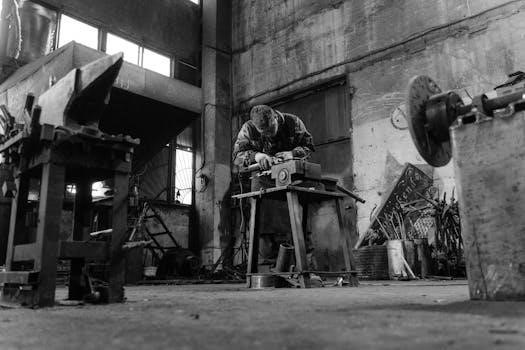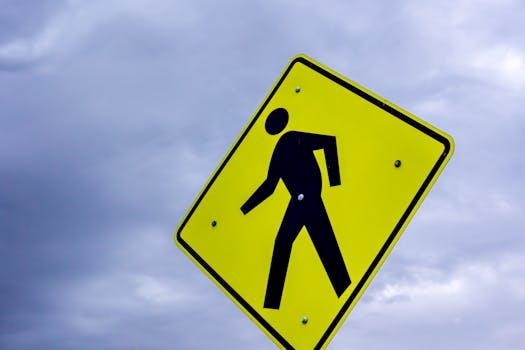
Angle grinders, versatile power tools found on construction sites, demand respect․ This guide covers uses, safety, and best practices for safe operation․ Prioritizing protection during work is paramount․ From choosing the correct cutting disc to understanding potential risks, knowledge ensures both efficiency and well-being․
What is an Angle Grinder?
An angle grinder, often called a side grinder or disc grinder, is a handheld power tool utilized for various applications, including cutting, grinding, polishing, and sharpening․ It’s a common sight on construction sites and in metalworking shops due to its versatility․ At its core, an angle grinder employs an abrasive wheel or disc that rotates at high speeds, allowing it to efficiently remove material from a workpiece․ These tools are typically powered by electricity, though pneumatic models also exist, offering flexibility depending on the work environment․
Angle grinders consist of several key components, including a motor, a spindle for attaching the disc, a guard to protect the operator from flying debris, and a handle for control․ The size of the disc varies, influencing the tool’s capabilities and applications․ Smaller discs are suitable for detail work, while larger discs are better for heavy-duty cutting and grinding․ Angle grinders are indispensable for tasks ranging from cutting metal pipes and removing rust to polishing surfaces and sharpening blades․ Their adaptability makes them a valuable asset for professionals and DIY enthusiasts alike․
Angle Grinder Uses
Angle grinders are exceptionally versatile tools with a wide range of applications across various industries and DIY projects․ One of the primary uses is cutting materials like metal, concrete, tile, and stone․ With the appropriate cutting disc, an angle grinder can quickly and efficiently slice through these materials, making it ideal for construction, renovation, and metal fabrication tasks․ Grinding is another common application, where the tool is used to smooth rough edges, remove rust, and prepare surfaces for welding or painting․
Furthermore, angle grinders are frequently employed for polishing and finishing surfaces․ By attaching polishing pads or flap discs, they can create a smooth, professional-looking finish on metal, wood, and other materials․ They can also be used for sharpening blades, such as lawnmower blades or garden tools, restoring their cutting efficiency․ In construction, angle grinders are invaluable for tasks like removing excess mortar, cutting rebar, and shaping concrete․ Their adaptability makes them an essential tool for any job site or workshop, offering a cost-effective solution for various material processing needs․
Angle Grinder Safety⁚ An Overview
Angle grinders, while versatile, demand strict adherence to safety protocols․ This overview emphasizes the critical aspects of safe operation to prevent injuries․ Kickback, where the disc is violently thrust away, poses a significant risk, potentially causing severe cuts․ Discs can also shatter or explode, projecting fragments at high speed․ Therefore, comprehensive safety measures are essential․
Always wear appropriate personal protective equipment (PPE), including wide-vision goggles or safety glasses with a face shield, to protect against flying debris․ Hearing protection is also crucial, given the high noise levels produced during operation․ Gloves should be worn to provide a secure grip and protect hands from abrasions and cuts․ Before each use, inspect the grinder for any signs of damage, ensuring that all guards are securely in place․ Never operate a grinder with a damaged or missing guard, as this significantly increases the risk of accidents․ Proper training on safe operating procedures is also vital․
Essential Safety Gear
Operating an angle grinder necessitates the use of essential safety gear to mitigate potential hazards․ Eye protection is paramount, demanding wide-vision goggles or safety glasses paired with a face shield․ These guard against flying debris generated during cutting or grinding operations․ Hearing protection, such as earmuffs or earplugs, is equally critical, shielding against the high noise levels that can lead to long-term hearing damage․
Gloves are essential for providing a secure grip and protecting hands from abrasions, cuts, and vibrations․ Depending on the task, aprons or other protective clothing may be necessary to shield the body from sparks and debris․ Furthermore, metatarsal safety boots are recommended to safeguard feet from falling objects and sharp materials․ Respiratory protection, like a dust mask or respirator, is crucial when working with materials that produce dust or fumes, preventing inhalation of harmful particles․

Selecting the appropriate safety gear is paramount to ensure a secure and protected work environment․ Prioritize quality and fit when choosing your PPE․
Checking the Grinder Before Use
Prior to initiating any grinding or cutting task, a thorough inspection of the angle grinder is essential․ Begin by verifying the integrity of the grinding wheel or cutting disc․ Ensure it is the correct type for the intended material and free from cracks, chips, or any signs of damage․ Never use wheels that vibrate excessively, as this indicates a potential structural issue․
Next, inspect the grinder’s wheel guard․ Confirm that it is securely in place and properly adjusted to deflect debris away from the operator․ The guard should never be removed or modified․ Examine the power cord for any frays, cuts, or exposed wires․ A damaged cord poses a serious electrical hazard․
Test the dead-man switch, also known as the constant pressure switch, to ensure it functions correctly․ The grinder should only operate when the switch is depressed and immediately stop when released․ Lastly, confirm that all components, such as the spindle nut and flanges, are properly tightened․ Addressing these issues can significantly improve safety․
Proper Technique
Employing the correct technique is crucial for safe and effective angle grinder operation․ Always maintain a firm grip on the grinder with both hands, ensuring complete control throughout the process․ Position yourself so that you have a stable stance and can comfortably reach the workpiece without overextending․
When grinding, hold the disc at a 15 to 30-degree angle to the object, applying consistent pressure․ Avoid bumping the grinder onto the material or allowing the disc to contact any other object while in use․ Ensure the workpiece is securely held, either as part of a larger item or clamped in a bench vice․
Let the grinder reach full speed before making contact with the material․ Guide the grinder smoothly along the cut line or across the grinding surface, avoiding sudden movements or excessive force․ Never force the grinder; allow the abrasive wheel to do the work․
Be mindful of the direction of sparks and debris, positioning yourself to avoid exposure․ If possible, keep the work at waist height to maintain better control and reduce strain․
Work Area Safety
Maintaining a safe work area is paramount when using an angle grinder․ Begin by ensuring the area is clean, well-lit, and free from clutter․ Cluttered or dark areas significantly increase the risk of accidents․ Remove any flammable materials from the vicinity, as sparks generated by the grinder can easily ignite them․
Ensure adequate ventilation to prevent the build-up of dust and fumes․ If working indoors, open windows or use a fan to circulate air․ When working outdoors, be mindful of wind direction to avoid spreading dust and debris to unintended areas․

Establish a clear safety zone around the work area, keeping bystanders at a safe distance․ Use barriers or warning signs to alert others to the potential hazards․ Before starting, inspect the floor for trip hazards and remove or mark them clearly․
After completing the work, thoroughly clean the area, removing any debris or metal shavings․ Store the angle grinder and accessories in a safe and secure location, away from children and unauthorized personnel․ A tidy workspace contributes significantly to preventing accidents and injuries․
Selecting the Right Cutting Disc
Choosing the correct cutting disc for your angle grinder is crucial for both safety and efficiency․ Different materials require specific disc types to ensure clean cuts and prevent accidents․ For metal cutting, opt for a reinforced abrasive disc designed specifically for metal․ These discs are typically made of aluminum oxide or silicon carbide․
When cutting stone or concrete, use a diamond-tipped blade․ Diamond blades are exceptionally durable and provide precise cuts through hard materials․ Ensure the blade is rated for the specific type of stone or concrete you are working with․
Always check the disc’s maximum RPM (revolutions per minute) rating and ensure it matches or exceeds the RPM rating of your angle grinder․ Using a disc with a lower RPM rating than your grinder can cause the disc to shatter, leading to serious injury․
Inspect the disc for any signs of damage, such as cracks or chips, before each use․ Never use a damaged disc, as it is more likely to break during operation․ Store cutting discs in a dry, secure location to prevent damage and maintain their integrity․ Proper disc selection significantly enhances safety and optimizes cutting performance․
Angle Grinder Maintenance
Regular maintenance is essential for ensuring the longevity and safe operation of your angle grinder․ Begin by unplugging the grinder from the power source before performing any maintenance tasks․ Regularly inspect the power cord for damage, such as cuts or fraying, and replace it if necessary․
Clean the grinder after each use to remove dust and debris, which can accumulate and affect performance․ Use a brush or compressed air to clean the motor vents and other components․ Check the condition of the grinding wheel or disc before each use, and replace it if it is worn, cracked, or damaged․
Periodically inspect the spindle lock mechanism to ensure it is functioning correctly․ A faulty spindle lock can make it difficult to change wheels or discs safely․ Lubricate moving parts, such as the gears and bearings, according to the manufacturer’s recommendations․ This helps to reduce friction and wear․
Store the angle grinder in a dry, secure location to protect it from moisture and damage․ Keep a record of all maintenance performed on the grinder, including dates and descriptions of the tasks completed․ Consistent maintenance not only extends the life of your angle grinder but also ensures it operates safely and efficiently․
Avoiding Kickback
Kickback is a sudden, forceful reaction that occurs when the grinding wheel or cutting disc of an angle grinder becomes pinched, snagged, or bound in the material being worked on․ This can cause the grinder to lurch back violently, potentially leading to serious injury․ To avoid kickback, it’s crucial to maintain a firm grip on the grinder with both hands․ Position your body to the side of the grinder, rather than directly behind it, to minimize the risk of being struck if kickback occurs․
Always use the correct wheel or disc for the material you are cutting or grinding․ Ensure that the wheel is properly mounted and tightened before starting work․ Avoid applying excessive pressure to the grinder, as this can increase the likelihood of snagging․ Let the wheel do the work, and maintain a consistent speed and angle․

Be particularly cautious when working in corners or tight spaces, where the risk of pinching is higher․ If the grinder starts to bind, immediately release the power switch and allow the wheel to come to a complete stop before attempting to free it․ Consider using a grinder with anti-kickback features, such as electronic clutch or vibration control, to further reduce the risk․
Regularly inspect the workpiece for any signs of potential hazards, such as knots in wood or embedded objects in metal, that could cause the wheel to snag․ By following these precautions, you can significantly reduce the risk of kickback and ensure a safer working environment․
PPE Requirements
Using an angle grinder demands strict adherence to Personal Protective Equipment (PPE) requirements․ Eye protection is paramount; wide-vision goggles or safety glasses combined with a face shield are crucial․ These protect against flying debris and sparks generated during grinding and cutting․ Hearing protection, such as earplugs or earmuffs, is essential due to the high noise levels produced by angle grinders, preventing potential hearing damage․
Hand protection is equally important․ Wear heavy-duty gloves, preferably leather, to shield your hands from cuts, burns, and vibrations․ Depending on the task, consider gloves with enhanced grip to maintain control of the grinder․ Body protection is also necessary․ An apron or coveralls made from durable, fire-resistant material safeguards your clothing and skin from sparks and hot debris․
Foot protection is often overlooked but vital․ Metatarsal safety boots with steel toes provide protection against falling objects and sharp materials․ Respiratory protection might be required, especially when working with materials that generate dust or fumes․ A dust mask or respirator can prevent inhalation of harmful particles․ Assess the specific work environment to determine the appropriate level of respiratory protection․
Always inspect your PPE before each use to ensure it’s in good condition and fits properly․ Replace any damaged or worn-out items immediately․ Proper PPE is your first line of defense against the hazards associated with angle grinders, minimizing the risk of injury and ensuring a safer working environment․
Importance of Training
Comprehensive training is paramount for anyone operating an angle grinder․ Angle grinders, while versatile, pose significant risks if used improperly․ Training equips operators with the knowledge and skills necessary to handle the tool safely and effectively, reducing the likelihood of accidents and injuries․ Proper training covers a range of essential topics, including understanding the grinder’s components, selecting the appropriate grinding or cutting disc for the task, and performing pre-use inspections to identify potential hazards․
Furthermore, training should emphasize correct operating techniques, such as maintaining a proper grip, controlling the angle of the grinder, and avoiding excessive pressure․ It should also cover how to recognize and prevent kickback, a dangerous phenomenon where the grinder suddenly thrusts backward, potentially causing severe cuts or lacerations․ Safety protocols, including the use of appropriate Personal Protective Equipment (PPE), must be thoroughly addressed․
Training programs should also incorporate practical exercises under the supervision of experienced instructors․ This hands-on experience allows trainees to develop proficiency in handling the grinder and to apply the safety principles they have learned․ Refresher training should be provided periodically to reinforce safe practices and to introduce any new techniques or equipment․
Ultimately, investing in comprehensive angle grinder training is an investment in the safety and well-being of workers․ It ensures that operators are competent, confident, and capable of using the tool safely and effectively, minimizing the risk of accidents and promoting a culture of safety in the workplace․
Potential Risks of Using the Angle Grinder
Operating an angle grinder presents several potential risks that demand careful attention and adherence to safety protocols․ The high-speed rotating disc poses a significant hazard, as it can cause severe cuts, lacerations, and abrasions upon contact․ Kickback, a sudden and forceful reaction where the grinder is thrust back towards the operator, is another major concern, potentially leading to loss of control and serious injury․ The risk of kickback increases when the disc becomes pinched or snagged during operation․
Shattering or explosion of the grinding or cutting disc is another potential hazard․ Discs can fail due to excessive pressure, improper use, or pre-existing damage, sending fragments flying at high velocity․ These fragments can cause eye injuries, skin punctures, and other serious wounds․ Exposure to dust and debris generated during grinding or cutting operations is also a health risk․ Inhalation of these particles can lead to respiratory problems, such as silicosis or other lung diseases․
The intense noise produced by angle grinders can cause hearing damage over time․ Prolonged exposure without adequate hearing protection can result in permanent hearing loss․ Sparks generated during metal grinding pose a fire hazard, particularly in environments with flammable materials․ Electrical hazards, such as electric shock, are also present, especially if the grinder is not properly grounded or if the power cord is damaged․ Moving parts of the angle grinder can also cause entanglement injuries if loose clothing or hair gets caught․
Therefore, a thorough understanding of these potential risks is crucial for safe angle grinder operation․ Proper training, adherence to safety guidelines, and the consistent use of appropriate PPE are essential for minimizing these risks and preventing accidents․
